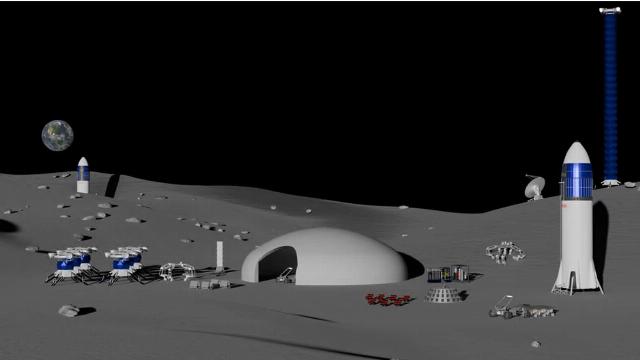The new American lunar program Artemis provides for the construction of a base on the Moon in which it will be possible to live for weeks. To create an ideal concept for the future lunar city, NASA organized a special project to collect the best proposals from American scientists. Recently, one of the US universities presented a variant of a special lunar infrastructure center, in which electricity should be transmitted using laser beams, and most of the work is automatically done by spider-like rovers.
During the first landing on the Moon in the last half century as part of the Artemis III mission, astronauts will have to spend several days on the Earth's natural satellite, but in the future the task is to organize all the conditions there for a multi-week life and research activities. The flight of the Artemis III crew is scheduled for 2027.
Meanwhile, many issues have not yet been resolved. For example, a spacesuit is not fully ready for astronauts, a lunar vehicle has not been built, ways to deal with electrified moon dust sticking everywhere have not been created, problematic lighting conditions at the South Pole of the Moon have not been thought out, and it is there that the base is to be built.: there are many deposits of water ice there, and from the water you can get hydrogen and oxygen, that is, rocket fuel.
Together with NASA, the American lunar base is being designed by the best minds in the United States: many universities in the country have sent their detailed designs of everything the Artemis astronauts will need to the agency. A team of young student scientists from the University of Illinois at Urbana—Champaign recently got their chance to participate in the creation of history: they developed a project for the American lunar program for an entire infrastructure center called THEIA - "Theia": in honor of the mythical mother Selene, the goddess of the Moon. According to the idea, the "maternal concern" for lunar explorers will be to solve four important issues: electricity, communications, transport and the development of lunar resources.
The concept provides for installation on the basis of seven retractable towers, which, when unfolded, have a height of 100 meters each. These towers are equipped with solar panels that generate 100 kilowatts of electricity each, a laser energy transmission system, lighting and communications equipment. Thus, it is both a constant source of electricity and, in fact, cell towers. Two stations on the surface have been designed to communicate with the Earth. However, due to the location, one of them cannot be used all the time.
Special "multi-armed" moon rovers should install and deploy all this. They look like spiders and are equipped with shovels, gripping devices, and even sintering techniques — bonding and sealing materials at high temperatures. With their help, you can lay and connect cables, and it is also an all—terrain vehicle in the full sense of the word - it crawls over almost any obstacle. They also plan to use this useful machine as an ambulance in the event of an astronaut having a problem, a lunar rover getting stuck somewhere, and so on. Additionally, other types of vehicles are also offered for the operational transportation of goods.
An awning with a volume of one thousand cubic meters is planned for the storage of equipment in THE THEIA center: a metal frame and a multilayer fabric with kevlar, a particularly durable fiber, which, by the way, is used for spacesuits. As a laboratory, it is proposed to use exactly the same inflatable module that serves as a residential one on the main Artemis base.
Finally, everything necessary is provided for the extraction of raw materials and the production of useful materials from it: machines for collecting regolith, an electrolysis device, storage for the obtained resources and, of course, their own power sources — nuclear reactors. There should be a total of four of them: two for the "mine" and two as an addition to the aforementioned towers with solar panels. What they intend to extract and from what: firstly, hydrogen and oxygen from lunar water, and secondly, aluminum, silicon, calcium and oxygen again from a mineral called anorthite (CaAl2Si2O8).
According to the authors of the concept, the basic set of all this infrastructure, together with towers, reactors and lunar rovers, weighs a total of 72 and a half tons, and this perfectly fits into the 100-ton payload limit of the lunar version of the Starship spacecraft. So the whole concept is completely based on the fact that it is used as an interplanetary transport.
Elizabeth Alexandrova

